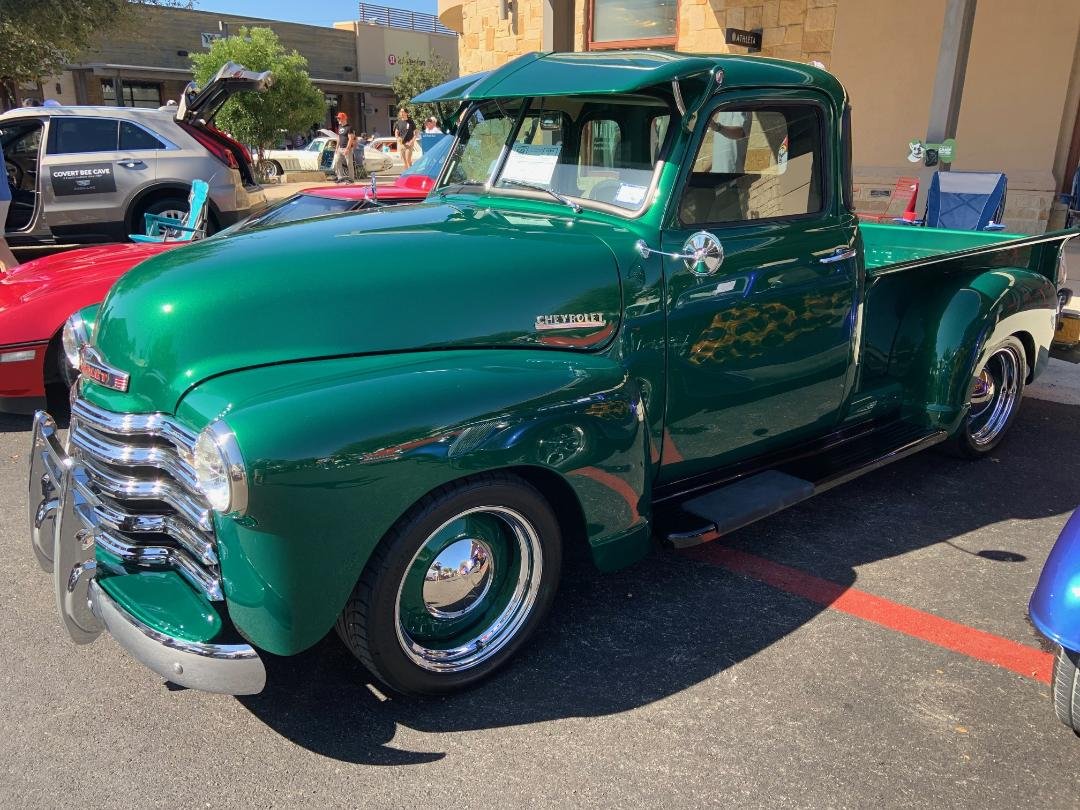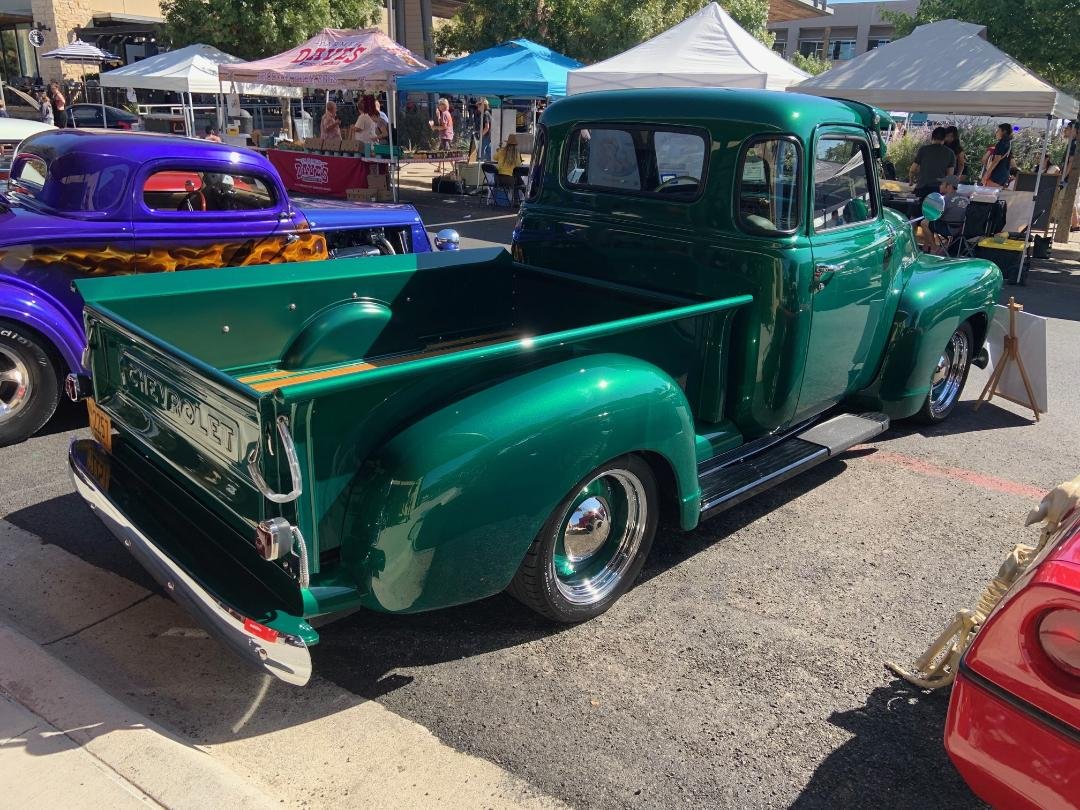Here is a nice looking, beautifully restored, 1949 Chevrolet 3100 Half Ton Pickup. This model was of the new Advance Design Chevy light trucks which was the first restyling after the end of WW 2. These new pickups replaced the AK lineup of trucks that ran from 1941 to 1947. General Motors was the first automaker to release the new post war truck restyling. Chevrolet introduced their new post war designed passenger cars about one year later.

The Advance Design which spanned the 1947 through 1955 model years ushered in many major changes and upgrades to Chevy light trucks. These Advance Design light trucks played a big role in the success Chevrolet had during the decade after the war. The new Advance Design cab was wider and offered more head and leg room.
Regarding the popularity of Chevy’s Advance Design, the Chevy Division was the number one truck manufacturer during all of the Advanced Design years. Advance Design light trucks used numeral identifiers. The 3100’s were half tons, 3/4-tons were designated 3600, and one ton trucks 3800.
1949 Chevy 3100 Light Truck Styling
With its robust, squared-off silhouette and distinctive chrome grille, this pickup exuded an undeniable sense of power and capability. Under the hood, the 3100 packed a potent inline six-cylinder engine.
While the five bar grille remained unchanged for the 1949 model year, a few other features had changed. One change was moving the great shift from the floor to the column which made room for a third person in the cab.
Hood side emblems now have CHEVROLET along with the series designation (3100, 3600, etc.) THRIFTMASTER on hood side emblems discontinued. Gas tank moved to inside the cab behind seat.
The truck’s sturdy steel frame and suspension system were engineered to withstand the rigors of hard labor.
With its distinctive rounded fenders, bold chrome grille, and sturdy, utilitarian frame hood emblem becomes chrome plated steel.
Chevrolet placed their new truck basic design on most commercial vehicles. Wheelbase on the commercial truck lines ranged from 116 inches all the way to 137 inches.
The Chevy light truck design remained virtually unchanged from 1947 through 1954.
1949 Chevy 3100 Specifications
The 1949 Chevy 3100’s were built with a 216 cubic inch inline-six engine delivering 90 HP. This was the only Chevy engine available from 1929 to 1955. There were no engine options in 1949. Chevrolet had eight cylinder engines from 1917 to 1919 then went to four cylinder engines. The six cylinder power plants came back in 1929 and remained the prime offering until 1955. At that time Chevy introduced their first small block V-8.
Standard transmission is a three speed manual with an option for a four speed manual. The four speed manual was fully synchronized.
Brakes are four wheel hydraulic drums.
The 1949 Chevy Half Ton Pickup has a wheelbase of 116.0 inches. Overall length 196.6 inches. New vehicle price in 1949 was about $1,253.
Total 1949 Chevrolet production came in at 1,018 vehicles. Total 1949 Chevy truck production was 345,500 vehicles. It’s estimated that about 200,000 were half ton pickups. Chevy produced the 3100 light pickup from 1947 to 1955.
Related Auto Museum articles include..
The 1947 Chevy Advance Design Pickup
 Total 1949 Chevrolet truck production was 345,500 vehicles.Reference material for this article includes…Chevrolet Pickups by author Mike Mueller. The book tells the story about how Chevy Trucks evolved over the years…GM HertitageCenter.com…Standard Catalog of American Light Duty Trucks by author John A. Gunnell.The 1949 Chevy truck design is one of the most iconic vehicle designs in history. It maintains strong collector popularity to this day. Current asking prices for the 1949 Chevy 3100 are strong. Like with all classic vehicles, prices are determined by condition, originality and general popularity. While an example in relatively good condition might be found in the $25,000 to $45,000 range, examples in excellent to perfect restored condition that are highly original have sold for considerably higher prices in the $60,000 to $100,0000 plus range.(Article and photos copyright Auto Museum Online)
Total 1949 Chevrolet truck production was 345,500 vehicles.Reference material for this article includes…Chevrolet Pickups by author Mike Mueller. The book tells the story about how Chevy Trucks evolved over the years…GM HertitageCenter.com…Standard Catalog of American Light Duty Trucks by author John A. Gunnell.The 1949 Chevy truck design is one of the most iconic vehicle designs in history. It maintains strong collector popularity to this day. Current asking prices for the 1949 Chevy 3100 are strong. Like with all classic vehicles, prices are determined by condition, originality and general popularity. While an example in relatively good condition might be found in the $25,000 to $45,000 range, examples in excellent to perfect restored condition that are highly original have sold for considerably higher prices in the $60,000 to $100,0000 plus range.(Article and photos copyright Auto Museum Online)
Protect your truck with this EzyShade 10-Layer Truck Cover Waterproof and All Weather. Full outdoor pickup truck covers. See the vehicle size chart on the link below…
Auto Museum Online searches for various products that we feel the classic car and automobile community in general can benefit from. As an Amazon Affiliate, Auto Museum Online earn a commission from qualifying purchases through my links, at no cost to you.
